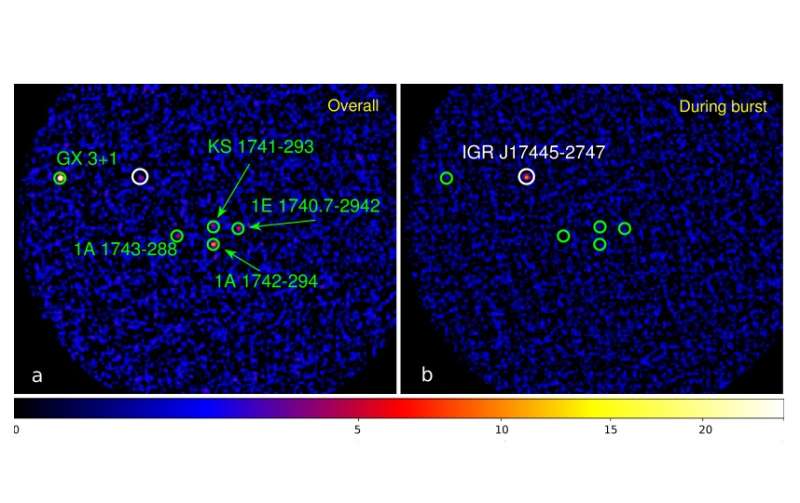JEM-X sky images (S/N maps) in the 3–20 keV band obtained on April 10, 2017: (a) over the entire observation during which the burst was detected; (b) within 13 s near the burst maximum. The detected bright persistent sources are indicated in the left image. The white circle marks IGR J17445-2747. Credit: Mereminskiy et al., 2017.
(Phys.org)—Using the JEM-X telescope onboard the INTEGRAL space observatory, astronomers have discovered a new X-ray burst in the galactic bulge. The X-ray burst was detected from the faint unidentified transient source know as IGR J17445-2747. The discovery is reported in a paper published Sept. 8 on arXiv.org.
First detected in 2003 by the IBIS/ISGRI gamma-ray telescope, IGR J17445-2747 was initially classified as a faint, unidentified persistent source. Subsequent observations of this source were conducted with the aim of detecting any outbursts that could be helpful in determining its nature. However, no such outbursts were discovered to date.
This situation changed in April 2017 when a team of Russian astronomers from the Space Research Institute in Moscow spotted a type I X-ray burst from IGR J17445-2747. The group, led by Ilya Mereminskiy, discovered the burst by analyzing the data obtained during scanning observations of the galactic center region with the Joint European X-ray Monitor (JEM-X) telescope onboard ESA's INTErnational Gamma-Ray Astrophysics Laboratory (INTEGRAL) space mission.
"We reported the detection of a type I X-ray burst from the poorly studied transient X-ray source IGR J17445-2747 in the galactic bulge," the researchers wrote in the paper.
X-ray bursts are among the most energetic events observed in the universe. They are believed to be thermonuclear explosions occurring near the surface of accreting neutron stars. Such events occur in low-mass X-ray binary systems where a neutron star and low-mass main sequence star are in orbit around one another.
Astronomers divide X-ray bursts into two categories: type I and type II. Type I bursts have a sharp rise followed by a slow and gradual decline of the luminosity profile, while type II bursts are characterized by a quick pulse shape, and may have many fast bursts separated by minutes. First X-ray burst was discovered in 1975 and so far, almost all of the detected X-ray bursts were found to be of type I.
New observations from the JEM-X instrument show that IGR J17445-2747 is another source exhibiting type I X-ray bursts. The newly detected burst has a shape typical for type I bursts, including a fast rise shorter than five seconds and a much slower decay lasting about 15 seconds. The findings indicate that IGR J17445-2747 is an accreting neutron star with a weak magnetic field in a low-mass X-ray binary.
"Such bursts are a sign of a thermonuclear explosion of accreted matter on the surface of a neutron star with a weak magnetic field in a low-mass X-ray binary. This is also confirmed by the almost blackbody spectrum detected during the burst," the paper reads.
Furthermore, few days after the discovery of the burst from IGR J17445-2747, the source was observed with the X-Ray Telescope (XRT) onboard NASA's Swift Gamma-Ray Burst Mission in order to estimate its accurate position. These observations allowed the researchers to determine that IGR J17445-2747 is most likely located in the galactic bulge, between 16,300 and 40,000 light years away from the Earth.
More information: IGR J17445-2747 - yet another X-ray burster in the Galactic bulge, arXiv:1709.02775 [astro-ph.HE] arxiv.org/abs/1709.02775
Abstract
The discovery of a type I X-ray burst from the faint unidentified transient source IGR J17445-2747 in the Galactic bulge by the JEM-X telescope onboard the INTEGRAL observatory is reported. Type I bursts are believed to be associated with thermonuclear explosions of accreted matter on the surface of a neutron star with a weak magnetic field in a low-mass X-ray binary. Thus, this observation allows the nature of this source to be established.
© 2017 Phys.org






















